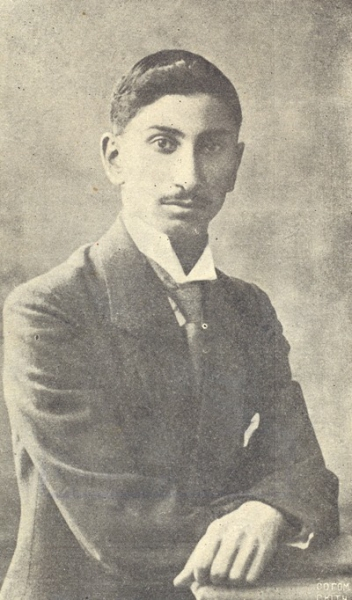Seyid Shushinski: mugham master who also performed on the opera stage
 Azerbaijani singer-khananda (mugham performer), musical figure and pedagogue Seyid Shushinski (real name Mir Mohsun Agha Seyid Ibrahim oghli) was born on April 12, 1889 in the village of Horadiz, Shusha uyezd (now city of Horadiz, Fuzuli district of Azerbaijan) in a merchant family.
Azerbaijani singer-khananda (mugham performer), musical figure and pedagogue Seyid Shushinski (real name Mir Mohsun Agha Seyid Ibrahim oghli) was born on April 12, 1889 in the village of Horadiz, Shusha uyezd (now city of Horadiz, Fuzuli district of Azerbaijan) in a merchant family.
[“Bakinskiy Rabochiy” newspaper №142 (21567) 06/18/1989., p. 3]
[Azerbaijani Soviet Encyclopedia, volume X, 1987, p. 581]
His first education Seyid received in the madrasah in his native village. Having lost his father early, Seyid was brought up first by his aunt, singer Khurzad, an educated and progressive woman for those times, and then by his uncle, who soon took him away to Shusha. A significant role in the formation of the musical talent of Seyid Shushinski was played by the Azerbaijani singer-khananda Jabbar Karyaghdy oghli.
[“Bakinskiy Rabochiy” newspaper № 142 (21567) 06/18/1989., p. 3]
[Azerbaijani Soviet Encyclopedia. volume X, 1987, p. 581]
According to the “Azerbaijan Soviet Encyclopedia” of 1987, Seyid studied at the music school of the Azerbaijani scientist, artist and musicologist Mir Mohsun Navvab in Shusha in 1907. However, in the book of Ch. Kajar “Old Shusha” (2007), it is indicated that Seyid Shushinski studied at the school of M.Navvab presumably in (or after) 1908.
“His first public concert (in Shusha), which ended in complete triumph, Seyid gave in 1908. At first, he sang “Mani”, then at the audience’s insistence he performed “Bayaty Shiraz” (mugams). After that, the audience was so enraptured and expressed their sympathies so noisily that Khanlyk Mukhtar, who was present at the concert (he was one of the most respected persons in the city), had to make two shots in the air to give Seyid the opportunity to sing the next item – “Sheker oghli” shikeste. After the concert, the popularity of the 19-year-old Seyid increased so much that crowds of people, wishing to invite Seyid to a wedding or to any celebration, gathered at the house of Seyid Ali. However, the uncle decided to continue Seyid’s education and sent him to study at Mir Mohsun Navvab, with whom he studied for two years”.
[Ch.Kajar. Old Shusha. 2007, p. 286]
[Azerbaijani Soviet Encyclopedia. Volume X, 1987, p. 581]
After the concerts in the city of Tiflis (now Tbilisi, Georgia) in 1911, Shushinski became known throughout Transcaucasia. In 1912, on the initiative of the Azerbaijani writer, editor of the Azerbaijani satirical magazine “Molla Nasreddin” Jalil Mammadkulizade and with the direct help of Seyid Shushinski, in the Sheytan Bazaar quarter, where the Azerbaijani population of Tiflis lived, there was opened the “Audience” Club. On the opening day of the club, under the leadership of Shushinski, there was organized an “Oriental Concert”, and the funds collected from the concert were donated by him to the club.
[Azerbaijani Soviet Encyclopedia. Volume X, 1987, p. 581]
Seyid Shushinski was one of the singers-khananda who appeared on the opera stage. He played the role of Ibn Salam in the opera “Leyli and Majnun”, Asker in the operetta “Arshin Mal Alan” and Sarvar in the operetta “Not that one, so this one” by the Azerbaijani composer Uzeyir Hajibeyov.
[Ch.Kajar. Old Shusha. 2007, p. 286]
Seyid Shushinski was popularly known as a patron of the arts, as he provided financial assistance to the Azerbaijani theater and actors, students in need, and also donated funds for the publication of the “Molla Nasreddin” magazine.
[Azerbaijani Soviet Encyclopedia. Volume X, 1987, p. 581]
[F.Shushinski. Shusha.1968, pp. 104-105]
In 1913-1914, a number of mughams performed by Seyid Shushinski were recorded on the gramophone records by the “Extraphone” joint-stock company in Kiev (now Ukraine).
[Azerbaijani Soviet Encyclopedia. Volume X, 1987, p. 581]
[“Bakinskiy Rabochiy” newspaper № 142 (21567) 06/18/1989., p. 3]
In 1924-1926, Shushinski was an artist of the Azerbaijan State Drama Theater, and in 1926-1933 he taught the art of mugham at the Azerbaijan State Conservatory (now the Hajibeyov Baku Academy of Music).
[Azerbaijani Soviet Encyclopedia. Volume X, 1987, p. 581]
In 1933-1938, Shushinski worked as the art director of the Karyagin (now Fizuli) Drama Theater, and in 1939-1960 he was a soloist of the Azerbaijani Radio and the Azerbaijan State Philharmonic named after Muslim Magomayev.
[Azerbaijani Soviet Encyclopedia. Volume X, 1987, p. 581]

Uzeyir Hajibeyov noted that Seyid Shushinski had his own independent and original creative path, and Azerbaijani composer Fikret Amirov described him as “a rare pearl of the treasury of the Azerbaijani people” and “the trembling heart of Azerbaijani music”.
[F.Shushinski. Shusha.1968, pp.104-105]
[“Bakinskiy Rabochiy” newspaper № 142 (21567) 06/18/1989., p. 3]
From 1943 until his death (1965), Shushinski taught mugham classes at the Asaf Zeynalli Music College (now the Baku Musical College at the Azerbaijan National Conservatory). In his last years, he also worked as a consultant on mugham operas at the Azerbaijan Opera and Ballet Theater.
[F.Shushinski. Shusha.1968, pp.104-105]
[Azerbaijani Soviet Encyclopedia. Volume X, 1987, p. 581]
In 1956 Seyid Shushenski was awarded the title of People’s Artist of the Azerbaijan SSR, and in 1961 the title of Honored Teacher of the republic. He was also awarded the Order “Badge of Honor”. The alumni of Seyid Shushinski were such Azerbaijani performers as Khan Shushinski, Zeynab Khanlarova, Hagigat Rzayeva, Abulfat Aliyev, Rubaba Muradova and Islam Rzayev.
[Azerbaijani Soviet Encyclopedia. Volume X, 1987, p. 581]
[“Bakinskiy Rabochiy” newspaper № 142 (21567) 06/18/1989., p. 3]
[F.Shushinski. Shusha.1968, pp. 104-105]
Seyid Shushinski died on November 1, 1965 in Baku.
[Azerbaijani Soviet Encyclopedia. Volume X, 1987, p. 581]
In 1989, the first international music festival “Khari-bulbul” held in Shusha was dedicated to the 100th anniversary of Seyid Shushinski.